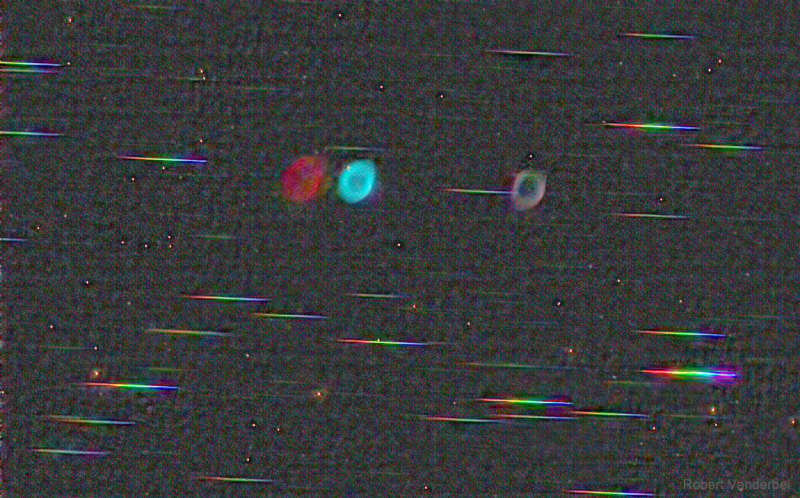Credit & Copyright: Robert Vanderbei
(Princeton U.)
Explanation:
What if you could see, separately, all the
colors of the Ring?
And of the surrounding stars?
There's technology for that.
The featured image shows the
Ring Nebula (M57)
and nearby stars through such technology: in this case, a
prism-like
diffraction grating.
The
Ring Nebula is seen only a few times
because it emits light, primarily, in only a few colors.
The two brightest emitted colors are
hydrogen
(red) and
oxygen (blue), appearing as nearly overlapping images to the left of the image
center.
The image just to the right of center is the
color-combined icon normally seen.
Stars, on the other hand, emit most of their light in colors all across the
visible spectrum.
These colors,
combined, make a nearly continuous streak --
which is why stars appear accompanied by multicolored bars.
Breaking object light up into colors is
scientifically useful because it can reveal the
elements that compose that object,
how fast that object is moving, and
how distant that object is.
1999 2000 2001 2002 2003 2004 2005 2006 2007 2008 2009 2010 2011 2012 2013 2014 2015 2016 2017 2018 2019 2020 2021 2022 2023 2024 2025 |
Yanvar' Fevral' Mart Aprel' Mai Iyun' Iyul' Avgust Sentyabr' Oktyabr' Noyabr' Dekabr' |
NASA Web Site Statements, Warnings, and Disclaimers
NASA Official: Jay Norris. Specific rights apply.
A service of: LHEA at NASA / GSFC
& Michigan Tech. U.
|
Publikacii s klyuchevymi slovami:
M 57 - Ring Nebula - Planetarnaya tumannost'
Publikacii so slovami: M 57 - Ring Nebula - Planetarnaya tumannost' | |
Sm. takzhe:
Vse publikacii na tu zhe temu >> | |
